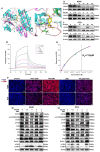A Novel Aniline Derivative from Peganum harmala L. Promoted Apoptosis via Activating PI3K/AKT/mTOR-Mediated Autophagy in Non-Small Cell Lung Cancer Cells
- PMID: 37628807
- PMCID: PMC10454575
- DOI: 10.3390/ijms241612626
A Novel Aniline Derivative from Peganum harmala L. Promoted Apoptosis via Activating PI3K/AKT/mTOR-Mediated Autophagy in Non-Small Cell Lung Cancer Cells
Abstract
Non-small cell lung cancer (NSCLC) is a common clinical malignant tumor with limited therapeutic drugs. Leading by cytotoxicity against NSCLC cell lines (A549 and PC9), bioactivity-guided isolation of components from Peganum harmala seeds led to the isolation of pegaharoline A (PA). PA was elucidated as a structurally novel aniline derivative, originating from tryptamine with a pyrrole ring cleaved and the degradation of carbon. Biological studies showed that PA significantly inhibited NSCLC cell proliferation, suppressed DNA synthesis, arrested the cell cycle, suppressed colony formation and HUVEC angiogenesis, and blocked cell invasion and migration. Molecular docking and surface plasmon resonance (SPR) demonstrated PA could bind with CD133, correspondingly decreased CD133 expression to activate autophagy via inhibiting the PI3K/AKT/mTOR pathway, and increased ROS levels, Bax, and cleaved caspase-3 to promote apoptosis. PA could also decrease p-cyclinD1 and p-Erk1/2 and block the EMT pathway to inhibit NSCLC cell growth, invasion, and migration. According to these results, PA could inhibit NSCLC cell growth by blocking PI3K/AKT/mTOR and EMT pathways. This study provides evidence that PA has a promising future as a candidate for developing drugs for treating NSCLC.
Keywords: CD133; NSCLC; PI3K/AKT/mTOR; aniline derivative; apoptosis; autophagy.
Conflict of interest statement
The authors declare that they have no competing financial interests or personal relationships that may have any influence on the work reported in this paper.
Figures








Similar articles
-
Ginsenoside Rg5 induces NSCLC cell apoptosis and autophagy through PI3K/Akt/mTOR signaling pathway.Hum Exp Toxicol. 2024 Jan-Dec;43:9603271241229140. doi: 10.1177/09603271241229140. Hum Exp Toxicol. 2024. PMID: 38289222
-
Luteoloside induces G0/G1 arrest and pro-death autophagy through the ROS-mediated AKT/mTOR/p70S6K signalling pathway in human non-small cell lung cancer cell lines.Biochem Biophys Res Commun. 2017 Dec 9;494(1-2):263-269. doi: 10.1016/j.bbrc.2017.10.042. Epub 2017 Oct 9. Biochem Biophys Res Commun. 2017. PMID: 29024631
-
Ganoderic acid DM induces autophagic apoptosis in non-small cell lung cancer cells by inhibiting the PI3K/Akt/mTOR activity.Chem Biol Interact. 2020 Jan 25;316:108932. doi: 10.1016/j.cbi.2019.108932. Epub 2019 Dec 23. Chem Biol Interact. 2020. PMID: 31874162
-
Molecular mechanism of palmitic acid and its derivatives in tumor progression.Front Oncol. 2023 Aug 9;13:1224125. doi: 10.3389/fonc.2023.1224125. eCollection 2023. Front Oncol. 2023. PMID: 37637038 Free PMC article. Review.
-
Natural products targeting autophagy and apoptosis in NSCLC: a novel therapeutic strategy.Front Oncol. 2024 Apr 2;14:1379698. doi: 10.3389/fonc.2024.1379698. eCollection 2024. Front Oncol. 2024. PMID: 38628670 Free PMC article. Review.
Cited by
-
Understanding the molecular regulatory mechanisms of autophagy in lung disease pathogenesis.Front Immunol. 2024 Oct 31;15:1460023. doi: 10.3389/fimmu.2024.1460023. eCollection 2024. Front Immunol. 2024. PMID: 39544928 Free PMC article. Review.
-
Unveiling the impact of CD133 on cell cycle regulation in radio- and chemo-resistance of cancer stem cells.Front Public Health. 2025 Feb 6;13:1509675. doi: 10.3389/fpubh.2025.1509675. eCollection 2025. Front Public Health. 2025. PMID: 39980929 Free PMC article. Review.
-
Isoquercitrin Suppresses Esophageal Squamous Cell Carcinoma (ESCC) by Inducing Excessive Autophagy and Promoting Apoptosis via the AKT/mTOR Signaling Pathway.Antioxidants (Basel). 2025 Jun 8;14(6):694. doi: 10.3390/antiox14060694. Antioxidants (Basel). 2025. PMID: 40563327 Free PMC article.
References
-
- Ding P.N., Lord S.J., Gebski V., Links M., Bray V., Gralla R.J., Yang J.C., Lee C.K. Risk of treatment-related toxicities from EGFR tyrosine kinase inhibitors: A meta-analysis of clinical trials of gefitinib, erlotinib, and afatinib in advanced EGFR-mutated non-small cell lung cancer. J. Thorac. Oncol. 2017;12:633–643. doi: 10.1016/j.jtho.2016.11.2236. - DOI - PubMed
-
- Li J.N., Chen P.C., Wu Q.S., Gio L.B., Leong K.W., Chan K.L., Kwok H.F. A novel combination treatment of antiADAM17 antibody and erlotinib to overcome acquired drug resistance in non-small cell lung cancer through the FOXO3a/FOXM1 axis. Cell. Mol. Life Sci. 2022;79:614. doi: 10.1007/s00018-022-04647-x. - DOI - PMC - PubMed
MeSH terms
Substances
Grants and funding
LinkOut - more resources
Full Text Sources
Medical
Research Materials
Miscellaneous

